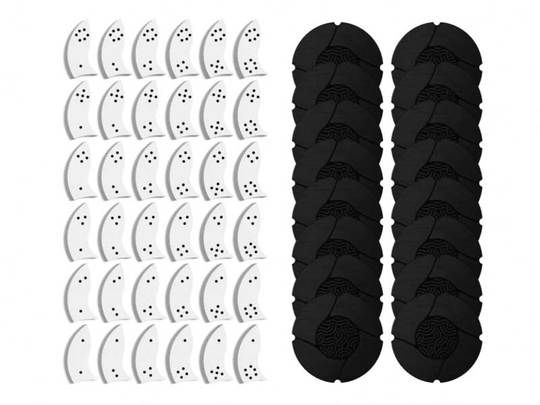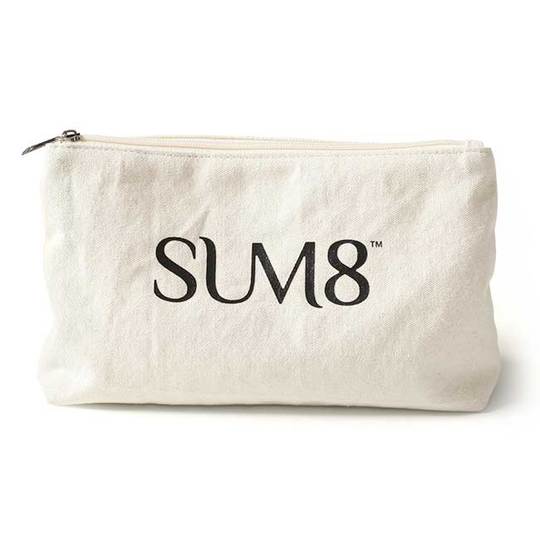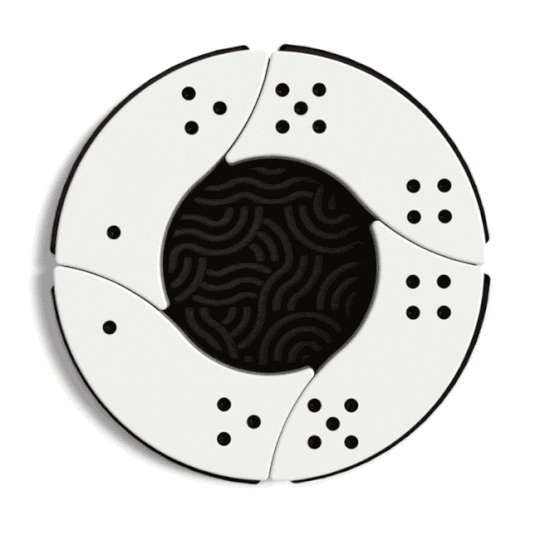My girlfriend and her family are avid “Dominos” players. I’ve picked up a thing or two but they’ve got the game down to a science. In other words, I rarely win. I may just introduce them to “SUM8”, a game currently seeking your support on Kickstarter, just so that I have a fair shot of winning…well, something. “SUM8” supports 1-2 players and ages 8+ with an average play time of 30 minutes. This game reminds me a little of “Dominos” what with the playing of numbered tiles on a flat surface, but it goes beyond in a number of ways.
Before we begin I’d like to thank Leanne Gray, Co-founder of Turnup Games, for providing me with a prototype for preview purposes. Prototypes are not often reflective of the finished product, making everything you see and read about here subject to change. I’m also required by FTC regulations to disclose that I was paid to cover this game, however any and all opinions are my own.
My prototype copy came with 16 black disks, the perimeter of which is broken up into quarter slots. There are also 36 white curved tiles with numbers on either side, similar to dominos, that fit in the quarter slots of the disks. All of that comes in a cotton travel bag.


The directions / instructions are pretty straight forward. Players will first decide how many of the black disks to use (9 hard – 16 easy) and how to arrange them on the table. The instruction manual provides a number of predetermined positions for ease of play. Once done, all 36 white tiles are mixed up, face down, with each player drawing 8 to form their private hand. Players can pick a random tile from the supply to see who goes first (highest pip count wins), with said tiles being shuffled back into the supply to be used again later.
On a player’s turn, they’ll do one of two things:
1. Play one tile from their hand, then draw a new one from the supply. A placed tile must touch an existing tile (the first played tile can go anywhere).
2. Move a tile. A tile can be moved so as long as the disk is not locked, meaning that it is full of tiles already. Players also cannot move a tile if it would cause a gap in the grid (all tiles must be adjacent to one another).
In either case, players must adhere to placement rules. The pips that touch each other (from the newly placed and the existing tile) must either match or add up to 8. As an example, if the one end of an existing tile has 3 pips, a player can either place / move a piece next to it whose end is either 3 pips or 5 pips.

Once a player performs one of the two actions above they score points. They score 1 point if the pips match and 2 points if the pips add up to 8. Any two disks / circles that touch form an “8”. Should a player close an 8 by filling the last piece of the disk, they earn 4 points plus whatever they would earn for the ends of the piece (matching or adding to 8).
Play continues until all of the tiles are used or one player cannot place any of their remaining tiles, at which point the their opponent gets one remaining turn. The pips in a player’s hand at the end of the game are counted against them, so getting rid of the high valued tiles is important. The player with the highest score wins.
The above doesn’t cover everything found in the rulebook, but should give you an idea as to how the game is played.

I would classify “SUM8” as one of those “easy to learn, hard to master” games that almost anyone can get into if they put their mind to it, similar to that of say, “Othello”. One of my complaints with “Dominos” is that a seasoned player knew how to count the remaining tiles to the point where they knew the game was over before it even was. My girlfriend constantly says things to me like, “Oh, you either have the 1/6 or the 2/3 in your hand”. Infuriating at times, but as someone who repeatedly kicks her behind in Chess I suppose it’s fair game.
I suppose what I’m getting at here is that “SUM8” is a bit more complex than Dominos and it’s not a game you can predict as easily. Sure, you’ve got a hand of numbered tiles and sure, you’re matching ends at times, but you’re also playing the long game like you would in “DOTS” in that you’re trying not to give your opponent the availability to close 8’s and score a bunch of points. This led to a lot of open 8’s, though sometimes you don’t have a choice depending on what you draw. As rage inducing as bad RNG (random number generating) is in terms of drawing poorly from the supply, there’s still a good bit of strategy required to play.
Throughout my testing session I was always at ends as to whether or not to keep the grid open or rid myself of those high valued / pipped pieces for fear of not being able to rid of them later. I often did the latter. Yes, I set up my opponent to score easy points, but I was hoping to go out first and leave them with nasty tiles in their hands that would reduce their score back to zero if at all possible. Of course, despite a player’s best-laid plans, lady luck may have other plans.
“SUM8” is a solid, even ambitious tile laying game that I’d easily be able to recommend to gamer couples of all types. Whether you’re a casual or hardcore gamer, “SUM8” is a great travel companion to keep you busy. There’s a solo mode available as well should you be alone and just need to pass a little time. All in all, “SUM8” is an interesting tile laying game that you should definitely check out.
Kickstarter: https://www.kickstarter.com/projects/turnupgames/sum8-a-clever-strategy-game-for-two
